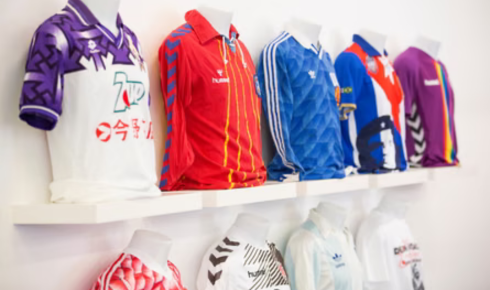There’s something almost magical about old football jerseys. They don’t just hang in closets—they live in them. Each one tells a story, whether it’s tied to a legendary goal, a painful loss, or simply the time you wore it while kicking a ball around with friends on a Sunday afternoon. Unlike brand-new kits, retro jerseys have character. They’re imperfect, sometimes a little faded, but that’s what makes them beautiful. They carry memory in every thread.
I think that’s why retro shirts have exploded in popularity again. Fans aren’t just chasing fashion—they’re chasing a connection to moments they can’t let go of. And in football, those moments are everything.
Few jerseys embody this more than Argentina’s iconic sky blue and white stripes. To hold an argentina retro jersey in your hands is to hold decades of history—Diego Maradona’s genius in ’86, Messi’s long road of heartbreak and redemption, and countless World Cup campaigns that made Argentina one of the most emotional football nations on earth.
There’s a purity to that shirt. It doesn’t need wild designs or flashy experiments. Just stripes, simple and proud. Wearing it feels like wearing passion itself. For Argentines, it’s more than clothing—it’s identity. And for fans around the world, it’s a tribute to artistry and grit on the biggest stage.
Then, of course, there’s Brazil. If football has a color, it’s yellow—and the brazil retro jersey is one of the most recognized shirts in the world. Pelé lifting trophies, Ronaldo’s brilliance, Ronaldinho’s smile—it’s all tied to that golden kit with green trim. It screams joy, creativity, and samba rhythm in motion.
What I love most about Brazil’s shirt is how it reflects their style of play. It’s bright, bold, and unafraid to stand out, just like their football. Whether it’s a retro kit from the 70s or 90s, slipping one on feels like channeling the soul of the beautiful game. You don’t just wear it—you feel lighter, like maybe you too could pull off a no-look pass or a bicycle kick.
France’s story is a little different, but no less powerful. The france retro jersey is elegant, stylish, and somehow unmistakably French. Think back to the 1998 World Cup—the red stripe across the chest, Zidane’s brilliance, the euphoria of a nation lifting its first star. Or the 1984 Euros, when Platini dazzled in blue. Each retro kit feels like a postcard from those golden moments.
France has a knack for combining fashion with football. Their retro shirts don’t just look good on the pitch—they look good on the streets, in cafés, in music videos. They blend sport and culture seamlessly, which is maybe why so many people still wear them proudly, decades later.
But retro jerseys aren’t just about teams or trophies. They’re about nostalgia. They remind us of being younger, of staying up late to watch matches we weren’t supposed to, of wearing oversized kits that nearly touched our knees. They remind us of posters on our walls, sticker albums, and playground debates about who was the greatest.
Today, when you see someone rocking an old jersey, you know it means something. Maybe it’s their way of honoring a player they idolized. Maybe it’s just about standing out in a sea of new-season replicas. Either way, retro kits carry personality in a way fresh releases rarely can.
And there’s another layer too: retro jerseys are conversation starters. Walk into a bar in Buenos Aires with a vintage Argentina shirt, and someone will definitely nod in recognition. Wear an old France kit in Paris, and you might hear a story from a local about where they were in ’98. Put on a classic Brazil top anywhere in the world, and strangers will smile, remembering the joy that team brought them.
They’re not just shirts. They’re icebreakers. They’re time machines. They’re proof that football is bigger than borders or languages.
Of course, it’s not all romance—there’s also the collector’s obsession. Retro jerseys have become a market of their own. Original kits from past tournaments sell for staggering prices, sometimes thousands. But even replicas, reissued by brands, carry that charm. They let fans relive history without spending a fortune. And honestly, even if they’re mass-produced, they still feel special.
There’s something different about pulling on a retro kit compared to a brand-new one. The new kit says, “This is who I support right now.” The retro kit says, “This is what I’ve always loved.” It’s a subtle difference, but an important one.
And maybe that’s why retro jerseys hit us so hard—they’re about permanence in a sport that changes constantly. Managers come and go. Players swap clubs. Sponsors change, stadiums get rebuilt, rules are rewritten. But that old shirt, the one tied to a memory, doesn’t change. It stays exactly as it was when the moment happened.
Sometimes I think football is a little cruel. The highs never last long enough, and the lows feel endless. But retro jerseys soften that blow. They let us relive the good bits whenever we want.
At the end of the day, retro jerseys are more than collectibles or fashion. They’re little pieces of the game’s soul. They let us carry legends on our backs, walk with memories stitched across our chests, and connect with strangers through a shared glance.
Whether it’s Argentina’s stripes, Brazil’s yellow, or France’s blue, these shirts remind us why football matters. Because football isn’t just about the present—it’s about everything that came before, and everything it made us feel along the way.
And really, isn’t that why we love the game?

